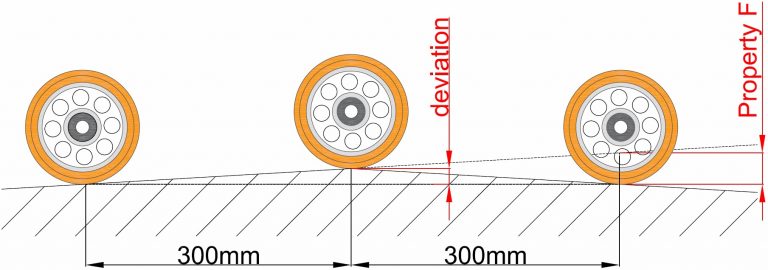TR34 2013 4th Edition Free Movement Floor Classifications
According to TR34 2013 (4th Edition) Free Movement floors and associated construction tolerances are not intended for very narrow aisles, where a defined movement specification should be used.
The surface regularity is controlled in two ways;
1. Appropriate flatness (Property F)
2. Appropriate levelness (Property E)
Each of these properties has got their limits which have to be achieved in order to ensure that the floor as a whole with all its static and mobile equipment can operate safely and efficiently.
Flatness Explained
Flatness is surface regularity characteristics measured between two points over a short distance, typically 300mm.
To control flatness (the change in elevational difference between two consecutive measurements 300mm apart of each other) TR34 2013 specifies Property F limits, which can be found in table 3.1 of TR34 2013 4th Edition shown below.
Property F (flatness) is measured using specialist digital equipment DABROS Digital Property F Recorder with accuracy of 0.1mm, and all measurements are taken at 10mm intervals. The DABROS Digital Property F Recorder is pulled along the randomly chosen grid lines on the Free Movement area. The survey data is continuously collected by a phone connected via Bluetooth with the device and later analysed using our specialist software, which generates graphs for each individual survey run.
Below graphical illustration of how the Property F is measured.
Table 3.1: Permissible 95 percentile values on Properties F
| Floor Classification | Typical floor use | Property F 95th Percentile Limit |
FM 1 | Where very high standards of flatness and levelness are required. | 1.8 |
FM 2 | Reach trucks operating at 8 to 13m without side-shift. | 2.0 |
FM 3 | Retail floors to take directly applied finishes | 2.2 |
FM 4 | Retail floors to take applied screeds. | 2.4 |
Levelness Explained
Levelness is surface regularity characteristics measured over a long distance, typically 3m. Also, any point on the floor has to be within +/-15mm from a datum, which is usually set at the start of the construction of a building.
To control levelness TR34 2013 specifies Property E limits, which can also be found in table 3.1 of TR34 2013 4th Edition shown below.
Table 3.1: Permissible 95 percentile values on Properties E
| Floor Classification | Typical floor use | Property F 95th Percentile Limit |
FM 1 | Where very high standards of flatness and levelness are required. | 4.5 |
FM 2 | Reach trucks operating at 8 to 13m without side-shift. | 6.5 |
FM 3 | Retail floors to take directly applied finishes | 8.0 |
FM 4 | Retail floors to take applied screeds. | 10.0 |
Limits explained
Each of the properties (Property F and Property E) have 95th Percentile limits.
In order for the floor to comply with the required classification, following criteria have to be achieved:
1. No more than 5% of all Property F measurements (all survey lines combined) exceeds the 95th Percentile limit of the required classification,
Example:
FM2 – 95% of all measurements combined must have values of max. +/-2.0mm or less in order to comply with the required classification.
2. No more than 5% of all Property E measurements (all level differences between adjacent points) exceeds the 95th Percentile limit of the required classification,
Example:
FM2 – 95% of all level differences between adjacent points must have values of max. +/-6.5mm or less in order to comply with the required classification.
3. None of the Property E result on the floor is outside ± 15 mm of datum.
Non Compliance
Where more than 5% of all the measurements are greater than the 95th Percentile limit (for both Property F and Property E) , TR34 2013 recommends that the individual measurements are examined in detail to determine their significance before any remedial actions are taken. Minor variations are unlikely to affect the performance of a floor (disadvantages of this can often outweigh the advantages) and remedial actions such as surface grinding will affect the appearance of the floor.



